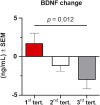Curiosity-Based Interventions Increase Everyday Functioning Score But Not Serum BDNF Levels in a Cohort of Healthy Older Adults
- PMID: 35822037
- PMCID: PMC9261453
- DOI: 10.3389/fragi.2021.700838
Curiosity-Based Interventions Increase Everyday Functioning Score But Not Serum BDNF Levels in a Cohort of Healthy Older Adults
Abstract
An enriched environment is effective in stimulating learning and memory in animal models as well as in humans. Environmental enrichment increases brain-derived neurotrophic factor (BDNF) in aged rats and reduces levels of Alzheimer-related proteins in the blood, including amyloid-β (Aβ) peptides and misfolded toxic forms of tau. To address whether stimulation of curiosity, which is a form of enrichment, may provide a buffer against Alzheimer's disease (AD), we measured levels of biomarkers associated with AD at baseline and after a 6-week intervention in older adults (>65 years of age) randomized to one of three different intervention conditions. Specifically, in this pilot study, we tested the effectiveness of a traditional, structured learning environment compared to a self-motivated learning environment designed to stimulate curiosity. There were no significant differences from baseline to post-intervention in any of the groups for Aβ42/Aβ40 ratio or t-tau (total-tau) plasma levels. Serum BDNF levels decreased significantly in the control group. Interestingly, individuals who had the lowest serum BDNF levels at baseline experienced significantly higher increases in BDNF over the course of the 6-week intervention compared to individuals with higher serum BDNF levels at baseline. As expected, older individuals had lower MoCA scores. Years of education correlated negatively with Aβ levels, suggesting a protective effect of education on levels of this toxic protein. ECog scores were negatively correlated with BDNF levels, suggesting that better performance on the ECog questionnaire was associated with higher BDNF levels. Collectively, these findings did not suggest that a 6-week cognitive training intervention focused on curiosity resulted in significant alterations in blood biomarkers but showed interesting correlations between cognitive scores and BDNF levels, further supporting the role of this trophic factor in brain health in older adults.
Keywords: Alzheimer’s disease; amyloid; brain-derived neurotrophic factor; curiosity; memory; t-tau.
Copyright © 2021 Grossberg, Bettcher, Gorgens and Ledreux.
Conflict of interest statement
The authors declare that the research was conducted in the absence of any commercial or financial relationships that could be construed as a potential conflict of interest.
Figures



Similar articles
-
Brain-derived neurotrophic factor and TrkB expression in the "oldest-old," the 90+ Study: correlation with cognitive status and levels of soluble amyloid-beta.Neurobiol Aging. 2015 Dec;36(12):3130-3139. doi: 10.1016/j.neurobiolaging.2015.08.022. Epub 2015 Aug 29. Neurobiol Aging. 2015. PMID: 26410307 Free PMC article.
-
BDNF mediates improvement in cognitive performance after computerized cognitive training in healthy older adults.Alzheimers Dement (N Y). 2022 Aug 30;8(1):e12337. doi: 10.1002/trc2.12337. eCollection 2022. Alzheimers Dement (N Y). 2022. PMID: 36089933 Free PMC article.
-
Reciprocal Predictive Relationships between Amyloid and Tau Biomarkers in Alzheimer's Disease Progression: An Empirical Model.J Neurosci. 2019 Sep 11;39(37):7428-7437. doi: 10.1523/JNEUROSCI.1056-19.2019. Epub 2019 Jul 26. J Neurosci. 2019. PMID: 31350262 Free PMC article.
-
Environmental Enrichment Effects on the Brain-Derived Neurotrophic Factor Expression in Healthy Condition, Alzheimer's Disease, and Other Neurodegenerative Disorders.J Alzheimers Dis. 2022;85(3):975-992. doi: 10.3233/JAD-215193. J Alzheimers Dis. 2022. PMID: 34897089 Review.
-
Peripheral Brain-Derived Neurotrophic Factor Levels in Alzheimer's Disease and Mild Cognitive Impairment: a Comprehensive Systematic Review and Meta-analysis.Mol Neurobiol. 2017 Nov;54(9):7297-7311. doi: 10.1007/s12035-016-0192-9. Epub 2016 Nov 4. Mol Neurobiol. 2017. PMID: 27815832
Cited by
-
Cognitive Stimulation and Its Effects on Well-Being, Executive Functions, and Brain-Derived Neurotrophic Factor in Older Adults from a Mexican Geriatric Center: A Quasi-Experimental Study.Nurs Rep. 2025 Apr 30;15(5):151. doi: 10.3390/nursrep15050151. Nurs Rep. 2025. PMID: 40423185 Free PMC article.
References
-
- Aicardi G., Argilli E., Cappello S., Santi S., Riccio M., Thoenen H., et al. (2004). Induction of Long-Term Potentiation and Depression Is Reflected by Corresponding Changes in Secretion of Endogenous Brain-Derived Neurotrophic Factor. Proc. Natl. Acad. Sci. 101 (44), 15788–15792. 10.1073/pnas.0406960101 - DOI - PMC - PubMed
-
- Barco A., Patterson S., Alarcon J. M., Gromova P., Mata-Roig M., Morozov A., et al. (2005). Gene Expression Profiling of Facilitated L-LTP in VP16-CREB Mice Reveals that BDNF Is Critical for the Maintenance of LTP and its Synaptic Capture. Neuron 48 (1), 123–137. 10.1016/j.neuron.2005.09.005 - DOI - PubMed
Grants and funding
LinkOut - more resources
Full Text Sources
Research Materials

